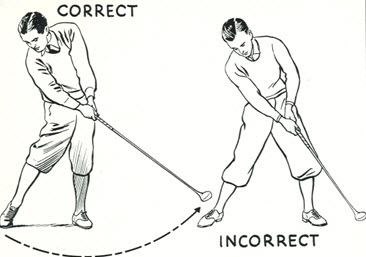Coordination of Several Factors Necessary to Make This Flatness Possible
Much has been said of the flatness noticeable at the bottom of the swinging arcs of all good players. Although it is important more as an indication than as a cause, it is nevertheless something that the average golfer should strive to attain.
It is a distinguishing mark of the consistent player.
The drawing, above, has been made from an actual position in the swing, with the approximate path of the club-head sketched in. Please observe that as the wrists were straightened out, the flatness made its appearance prior to contact.
In other words, this being a driving swing, the club-head reached the level of the ball a little before striking it, so that the blow was directed approximately horizontally and squarely against the back of the ball. Notice that the head of the club has not come up abruptly after impact, but is still relatively close to the ground.
Factors in Flat Arc
Obviously, the coordination of several factors has been necessary to make this flatness possible. One has been the shifting of the hips toward the ball in the earlier stages of the downstroke. Had the player “stayed back on his right foot”, his swing must have come up abruptly. Another factor has been the delay in straightening out the wrist bend, for this has made it possible for the head and right side to hold the swing down.
But of equal, if not greater importance, has been the player’s success in letting the club go. Upon a mere glance at the picture, one quite forcibly gets the impression that the club is being re-strained only by whatever force is necessary to keep it from leaving the hands. It is not so much being forced through as allowed to go freely after the ball.
Club-head Swinging Freely at Impact
The fact is that this club was swinging freely at impact. Every possible bit of power from hips, back, arms and hands had been used to give it speed and then–the club-head was freed, to expend its momentum on the ball and in the follow-through. The pose at the finish, which all of us like to visualize, as the epitome of grace, should be arrived at without further effort. The work has been done. The player’s balance should be so perfect that all effort will have subsided. The residual momentum of the club must do the rest.
The other illustration, Figure 14, presents an example of the type of swing that comes up abruptly from the ball. The final destructive factor has been the sudden shortening of the left arm. It is easy to see here that the club is being and has been restrained, instead of being allowed to use without diminution the energy stored up by the high velocity it had acquired.
